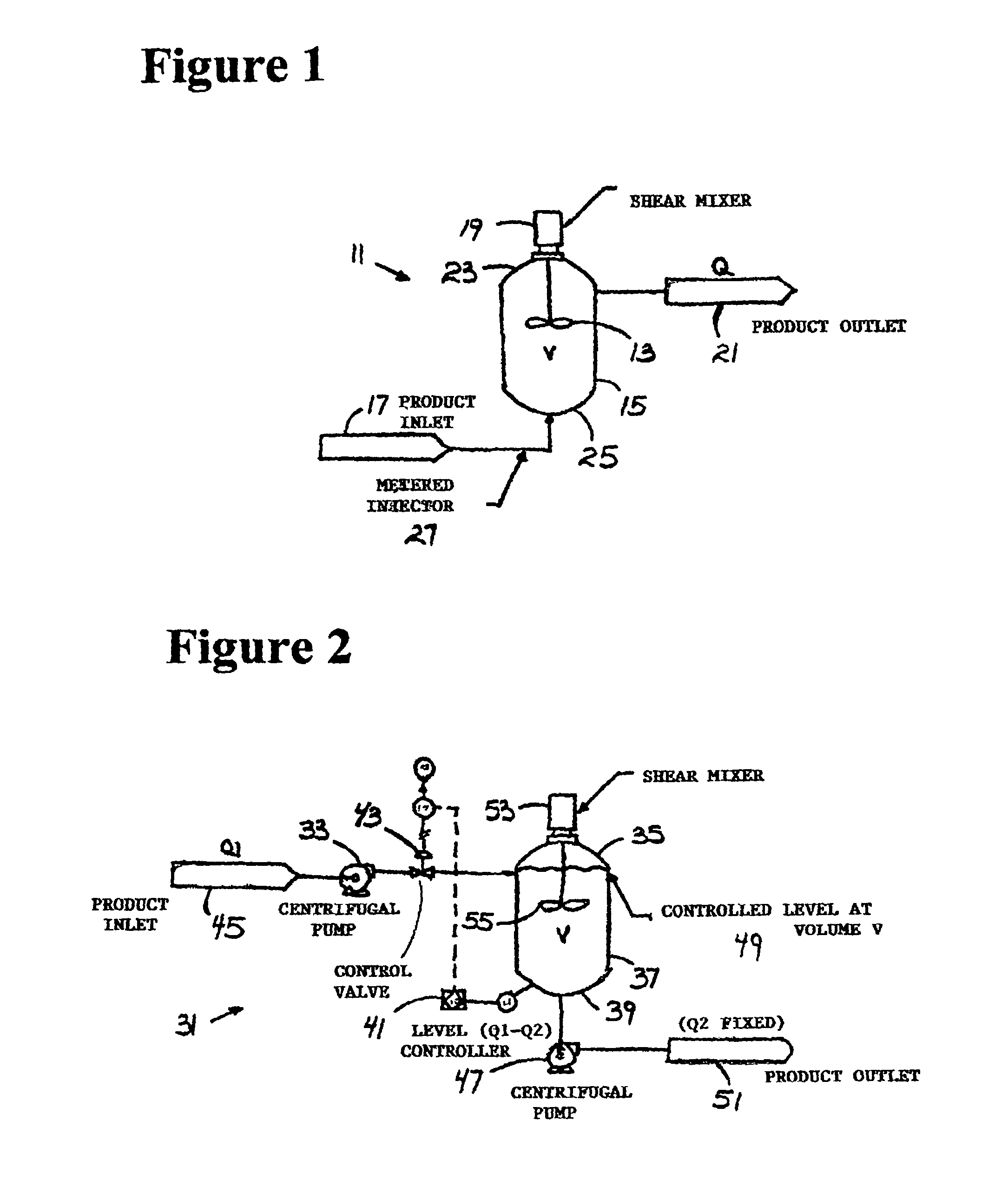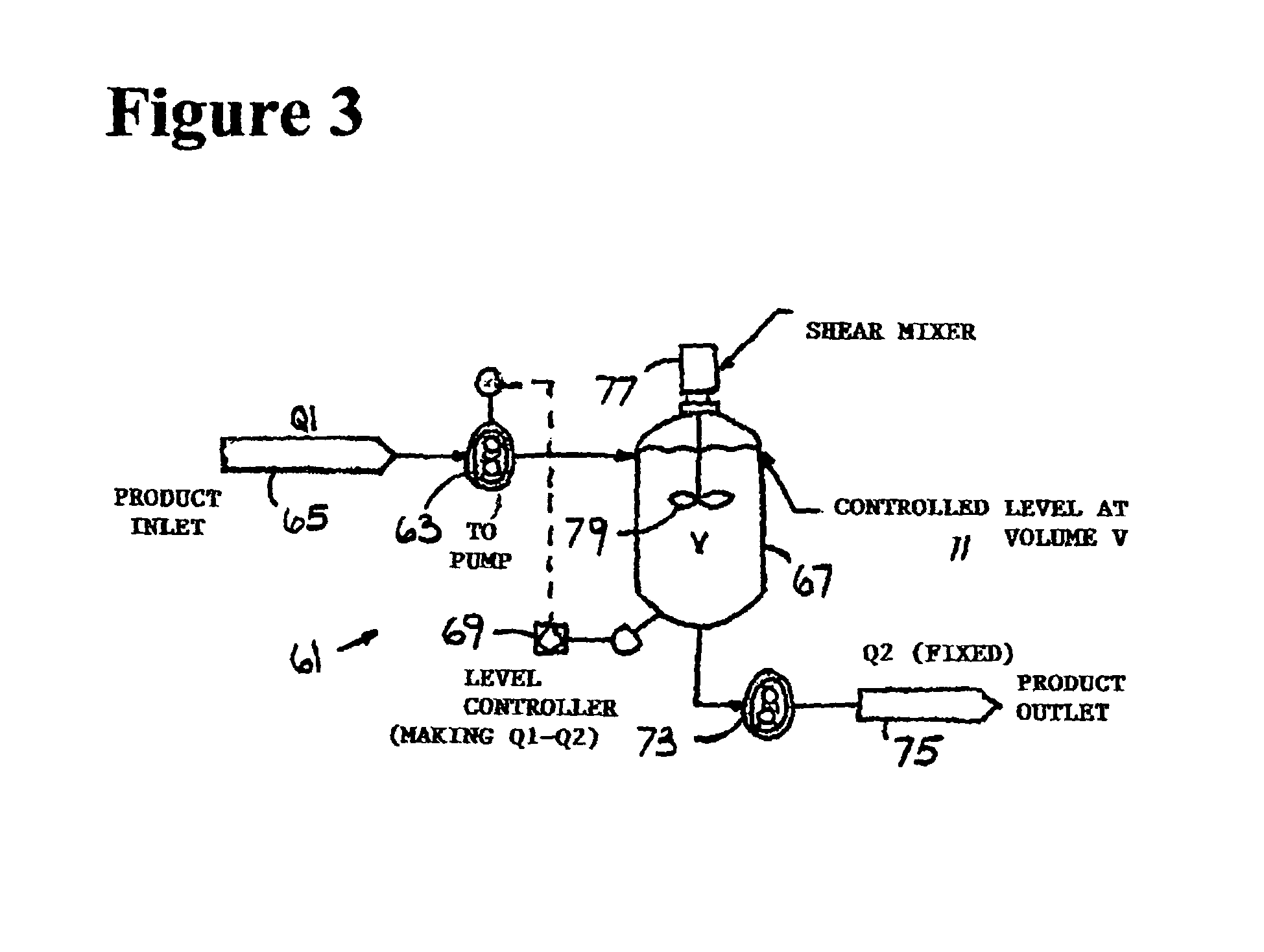Continuous high shear mixing process
a high shear and mixing technology, applied in the direction of process and machine control, transportation and packaging, instruments, etc., can solve the problems of high cost of conventional homogenizers, large amount of horsepower, and inability to use batch type shear mixers in most cases, so as to achieve energy saving and reduce capital costs
- Summary
- Abstract
- Description
- Claims
- Application Information
AI Technical Summary
Benefits of technology
Problems solved by technology
Method used
Image
Examples
embodiment 11
[0038]FIG. 1 is a schematic diagram of a constant flow embodiment 11 for an apparatus for preparing juice or beverages or any other product that requires homogenization, reduction of particle size, blending, solubilizing, dispersion, suspension, or emulsification. The vessel 11 is sized for the maximum needed residence time and is preferably open to atmosphere. The mixing chamber incorporates a batch shear mixer 13 in a tank 15 with a pressure seal that allows continuous flow. The device includes a product inlet 17, a holding tank 15 connected to the product inlet 17, a product shear mixer 13 mounted in the holding tank 15, a motor 19 connected to the shear mixer 13 for rotating the shear mixer 13 in the holding tank 15, and a product outlet 21 connected to the holding tank 15 for continuously and constantly flowing the product from the holding tank 15. The holding tank has a top 23 and a bottom 25 and the product inlet 17 is connected near a bottom 25 of the holding tank 15 and the...
embodiment 31
[0040]FIG. 2 is a schematic diagram of a variable flow embodiment 31 for low viscosity. Pumps 33 pump into a top 35 of a mixing chamber 37 and flow exits a bottom 39 of the tank 37. The device 31 is used with various products and / or variable flow rates. The vessel 31 is sized for the maximum needed residence time and is preferably open to atmosphere. The mixing chamber 37 incorporates a motor 53 connected to a batch shear mixer 55 in a tank 37. A level controller 41 controls a valve 43 or a positive displacement pump at the inlet 45. Systems are designed for use with various products and flow rates by sizing the mixing chamber 37 for the maximum needed residence time, opening the vessel to the atmosphere and installing a level monitor 41 in the tank 37. The volume, determined by the level, serves as a controlled process variable for residence time control. A variable speed extraction pump 47 controls the level on a closed loop control. When the incoming flow rate matches the outgoin...
embodiment 61
[0042]FIG. 3 is a schematic diagram of a variable flow embodiment 61 for high viscosity. This embodiment adds to the basic device a positive displacement pump 63 connected between a product inlet 65 and a holding tank 67, a level controller 69 connected to the holding tank 67 and connected to the inlet positive displacement pump 63 for controlling liquid level 71 in the holding tank 67, and an outlet positive displacement pump 73 connected between the holding tank 67 and a product outlet 75. A motor 77 controls a high shear mixer 79 in the holding tank
[0043]FIGS. 4, 5, and 6 show large hole, small hole, and slotted shearing heads 81, 83, 85 with central openings.
[0044]FIG. 7 shows an atmospheric residence tank 87 with coordinated inlet and outlet pumps 91, 93, shearhead motor 95, a shear mixer 97 in a screen 99 and a shearhead 81, 83, or 85.
[0045]The present invention also includes a method of providing juice or beverages or any other product that requires homogenization, reduction ...
PUM
 Login to View More
Login to View More Abstract
Description
Claims
Application Information
 Login to View More
Login to View More - R&D
- Intellectual Property
- Life Sciences
- Materials
- Tech Scout
- Unparalleled Data Quality
- Higher Quality Content
- 60% Fewer Hallucinations
Browse by: Latest US Patents, China's latest patents, Technical Efficacy Thesaurus, Application Domain, Technology Topic, Popular Technical Reports.
© 2025 PatSnap. All rights reserved.Legal|Privacy policy|Modern Slavery Act Transparency Statement|Sitemap|About US| Contact US: help@patsnap.com



